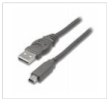Connecting your printer
Printer Services Newsletter 4.1
Welcome to a brand new year and the next chapter in our series of newsletters for 2014. This year we will be launching our online ordering system for all your toners and consumables. It has been designed to give you greater access to your printer needs. We will still be contactable to help you with any queries that you still might have regarding your printer or supplies.
Connecting your printer
Many of our customers ask us about the different ways that they can connect up their printer and what this means to their particular needs. So while in previous newsletters we have been telling you all about the printers, this time we will discuss connections to the computer.
There are several ways to connect the printer to the computer with one of the most common being the use of a USB cable. What used to be the most common method, a Parallel cable, has been replaced with the USB cable. The USB cable is faster, easier to install with Plug n Play technology and is less likely to go faulty than the Parallel cable. Due to the ridged wires, the Parallel cable tends to break if moved too often or bent at a right angle because the printer is too close to the wall. Another advantage the USB has over Parallel is you can have longer cables with less risk of data loss over the distance. This means that you don’t need to have the printer sitting right next to the computer giving you more desk space. (We recommend a maxium of 5 metre USB cables).
At the moment the most common USB cable type used is USB 2.0 which is the standard used in 90% of computers. At a transfer rate of 35 MB/sec (mega bytes per sec) they will quickly transfer all but the most complex documents to a printer. With the introduction of USB 3.0 which can transfer at up to 500MB/sec, even these documents will be a breeze to printout. Note at this time the Standard for USB 3.0 is still being worked on so it hasn’t been deployed to any printers yet to our knowledge.
USB and Parallel Cables

Parallel Cable - Up to 2 Mbit/sec
USB 1.1 Cable - Up to 12 Mbit/sec
USB 2.0 Cable - Up to 35 MB/sec
USB 3.0 Cable - Up to 500 MB/sec
Network Cables and Wireless

In networked situations a printer with network or wireless capabilities can be added to the network via a Cat 5 cable. Unlike USB or parallel cables, the type of Cat cable used does not always dictate the speed at which data is transfered from PC to printer.
When it comes to networking, the speed of the network card in the PC, the ports on the Switch/Router and the network port in the printer all effect the rate that the data is transfered at. The different ratings of Cat cable generally tell you how long the cable can be and the frequency that the data can be transmitted at. Most networks at the moment will be running at a base 100 (this means data is transmitted at up to 100 Mbits per sec) or base 1G (1Gigabit per second) speed.
As the cost reduces and the standards are defined we will hopefully see base 10G and base 40G networks in the future. The advantage of using a printer with a network card or print server of this rating, is that the transfer of data to printer will be extremely quick.

WE HAVE SERVICED MELBOURNE
SINCE 1997 OVER 25 YEARS



